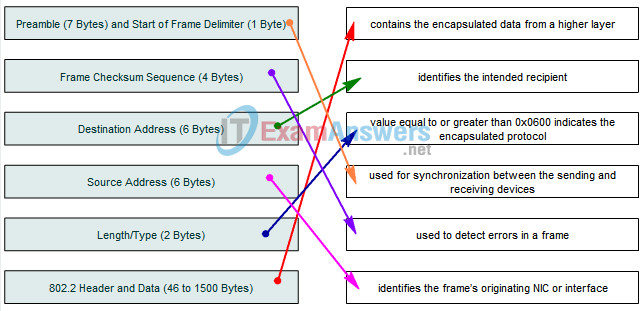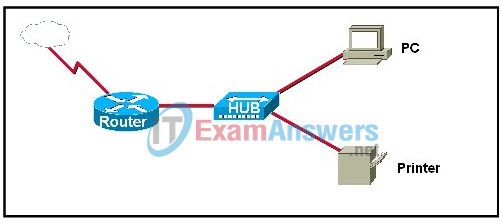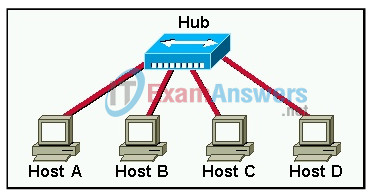1. Drag the Ethernet frame fields on the left and drop them onto their function on the right.

2. What is a primary function of CSMA/CD in an Ethernet network?
- assigns MAC addresses to hosts
- defines the area in which collisions can occur
- identifies the start and end of Ethernet frame
- provides a method to determine when and how hosts access the Ethernet medium
- creates the header in the Ethernet frame as data is encapsulated
- maps an IP address to a MAC address
3. What technology is the IEEE 802.3ac standard specifically designed to accommodate?
- Simple Network Management Protocol
- Address Resolution Protocol
- Virtual Local Area Network
- Voice over IP
- Internet Control message Protocol
4. What is the purpose of media access control?
- It identifies which workstation has sent a frame.
- It determines which Layer 3 protocol should handle a frame.
- It identifies which Ethernet frame format to use on the network.
- It determines which workstation on a shared medium LAN is allowed to transmit data.
5. How are collisions detected on an Ethernet network?
- Stations identify the altered FCS field on the colliding packets.
- The signal amplitude on the networking media is higher than normal.
- Traffic on the network cannot be detected due to a blockage
- The signal amplitude on the networking media is lower than normal.
6. Which Layer 2 sublayer provides services to the network layer of the OSI Model?
- FCS
- IEEE 802.3
- LLC
- MAC
7. Which devices shown in the graphic must have a MAC address?

- only PC
- only router
- PC and router
- PC, hub, and router
- PC, printer, and router
8. In the graphic, Host A has reached 50% completion in sending a 1 KB Ethernet frame to Host D when Host B wishes to transmit its own frame to Host C. What must Host B do?

- Host B can transmit immediately since it is connected on its own cable segment.
- Host B must wait to receive a CSMA transmission from the hub, to signal its turn.
- Host B must send a request signal to Host A by transmitting an interframe gap.
- Host B must wait until it is certain that Host A has completed sending its frame.
9. Which of the following are fields in an 802.3 Ethernet frame? (Choose three.)
- source physical address
- source logical address
- media type identifier
- frame check sequence
- destination physical address
- destination logical address
10. What address type does a switch use to make selective forwarding decisions?
- source IP
- destination IP
- source MAC
- destination MAC
